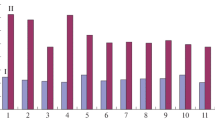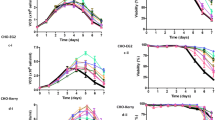Summary
Amino acid analyses of two biologically efficacious fractions from a peptone dialysate (PD) revealed high concentrations of glycine, presumably present in PD as glycine-rich peptides. Before undertaking further analyses of PD the growth-promoting abilities of several commercially available glycine peptides were tested with strain L (NCTC 2071) cells continuously subcultured in chemically defined medium NCTC 135, and with RH-PD cells which require peptone or peptone fractions for continued survival and proliferation. NCTC 2071 populations 5 to 10% greater than control cultures were obtained with 0.18 to 0.72mm peptide-supplemented medium NCTC 135; slightly better results were obtained with peptides containing an even number of glycine residues. No amplification of this response was observed after 28 to 29 weekly culture transfers in 0.72mm supplemented NCTC 135, and evidence suggested that the peptides were poorly hydrolyzed to monomeric glycine. Addition of the glycine peptides may permit use of a reduced minimum inoculum for NCTC 2071. Marked growth enhancement of peptone-dependent RH-PD cells was obtained only when glycine peptides were tested in the presence of 0.5 mg of PD per ml.
Similar content being viewed by others
References
Fedoroff, S., V. J. Evans, H. E. Hopps, K. K. Sanford, and C. W. Boone (organizers). 1971. Summary of proceedings of a workshop on serum for tissue culture purposes. In Vitro 7: 161–167.
Molander, C. W., A. J. Kniazeff, C. W. Boone, A. Paley, and D. T. Imagawa. 1971. Isolation and characterization of viruses from fetal calf serum. In Vitro 7: 168–173.
Boone, C. W., N. Mantel, T. D. Caruso Jr., E. Kazam, and R. E. Stevenson. 1971. Quality control studies on fetal bovine serum used in tissue culture. In Vitro 7: 174–189.
DeLuca, C., and A. V. Thomas. 1969. Serum contributions to culture medium: comparative dehydrogenase activity. Life Sci. 8: 1145–1156.
Esber, H. J., I. J. Payne, and A. E. Bogden. 1973. Variability of hormone concentrations and ratios in commercial sera used for tissue culture. J. Natl. Cancer Inst. 50: 559–562.
Paul, D., A. Lipton, and I. Klinger. 1971. Serum factor requirements of normal and simian virus 40-transformed 3T3 mouse fibroblasts. Proc. Natl. Acad. Sci. U.S.A. 68: 645–648.
Lipton, A., I. Klinger, D. Paul, and R. W. Holley. 1971. Migration of mouse 3T3 fibroblasts in response to a serum factor. Proc. Natl. Acad. Sci. U.S.A. 68: 2799–2801.
Lipton, A., D. Paul, M. Henahan, I. Klingner, and R. A. Holley. 1972. Serum requirements for survival of 3T3 and SV3T3 fibroblasts. Exp. Cell Res. 74: 466–470.
Wallis, C., B. Ver, and J. L. Melnick. 1969. The role of serum and fetuin in the growth of monkey kidney cells in culture. Exp. Cell Res. 58: 271–282.
Clarke, G. D., M. G. P. Stoker, A. Ludlow, and M. Thornton. 1970. Requirements of serum for DNA synthesis in BHK 21 cells: effects of density, suspension, and virus transformation. Nature (Lond.) 227: 798–801.
Dulbecco, R. 1970. Topoinhibition and serum requirement of transformed and untransformed cells. Nature (Lond.) 227: 802–806.
Jainchill J. L., and G. J. Todaro. 1970. Stimulation of cell growth in vitro by serum with and without growth factor. Exp. Cell Res. 59: 137–146.
Clarke, G. D., and M. G. P. Stoker. 1971. Conditions affecting the response of cultured cells to serum. In: G. E. W. Wolstenholme and J. Knight (Eds.),Growth Control in Cell Culture. Ciba Foundation Symposium, Churchill-Livingstone, London, pp. 17–32.
Frank, W., H.-J. Ristow, and S. Schwalb. 1972. Untersuchungen zur wachstumsstimulierenden Wirkung von Kalberserum auf Kulturen embryonaler Rattenzellen. Exp. Cell Res. 70: 390–396.
Griffiths, J. B. 1972. Role of serum, insulin and amino acid concentration in contact inhibition of growth of human cells in culture. Exp. Cell Res. 75: 47–56.
Dulak, N. C., and H. M. Temin. 1973. Multiplication-stimulating activity for chicken embryo fibroblasts from rat liver cell conditioned medium: a family of small polypeptides. J. Cell Physiol. 81: 161–170.
Waymouth, C. 1972. Construction of tissue culture media. In: G. H. Rothblat and V. J. Cristofalo (Eds.),Growth, Nutrition, and Metabolism of Cells in Culture. Academic Press, New York, Vol. 1, pp. 11–47.
Merril, C. R., T. B. Friedman, A. Attallach, M. R. Geier, K. Krell, and R. Larkin. 1972. Isolation of bacteriophage from commerical sera. In Vitro 8: 91–93.
Merril, C. R., M. R. Geier, and J. Petricciani. 1971. Bacterial virus gene expression in human cells. Nature (Lond.) 233: 398–400.
Chu, F. C., J. B. Johnson, H. C. Orr, P. G. Probst, and J. C. Petricciani. 1973. Bacterial virus contamination of fetal bovine serum. In Vitro 9: 31–34.
Evans, V. J., and W. F. Andresen. 1966. Effect of serum on spontaneous neoplastic transformationin vitro. J. Natl. Cancer Inst. 37: 247–249.
Price, F. M., R. R. Gant, and V. J. Evans. 1971. Effect of fractions of horse and fetal bovine serum on neoplastic conversion of C3H mouse cells in tissue culture. In Vitro 6: 437–440.
Waymouth, C. 1956. A serum-free nutrient solution sustaining rapid and continuous proliferation of Strain L (Earle) mouse cells. J. Natl. Cancer Inst. 17: 315–327.
Pumper, R. W. 1958. Adaptation of tissue culture cells to a serum-free medium. Science 128: 363.
Holmes, R. 1959. Long-term cultivation of human cells (Chang) in chemically defined medium and effect of added peptone fractions. J. Biophys. Biochem. Cytol. 6: 535–536.
Hsu, T. C., and D. J. Merchant. 1961. Mammalian chromosomesin vitro. XIV. Genotypic replacement in cell populations. J. Natl. Cancer Inst. 26: 1075–1083.
Lasfargues, E. Y., W. G. Coutinho, J. C. Lasfargues, and D. H. Moore. 1973. A serum substitute that can support the continuous growth of mammary tumor cells. In Vitro 8: 494–500.
Pumper, R. W., H. M. Yamashiroya, and L. T. Molander. 1965. Growth of mammalian cells in a heat-stable dialyzable medium. Nature (Lond.) 207: 662–663.
Taylor, W. G., M. J. Taylor, N. J. Lewis, and R. W. Pumper. 1972. Studies on a serum substitute for mammalian cells in culture. I. Biological efficacy of whole and fractionated peptone dialysate. Proc. Soc. Exp. Biol. Med. 139: 96–99.
Amborski, R. L., and M. Moskowitz. 1968. The effects of low molecular weight materials derived from animal tissues on the growth of animal cellsin vitro. Exp Cell Res. 53: 117–128.
Hsueh, H. W., and M. Moskowitz. 1973. A growth factor for animal cells derived from peptone. I. Isolation and characterization of the growth factor. Exp. Cell Res. 77: 376–382.
Spackman, D. H., W. H. Stein, and S. Moore. 1958. Automatic recording apparatus for use in the chromatography of amino acids. Anal. Biochem. 30: 1190–1206.
Moore, S., and W. H. Stein. 1963. Chromatographic determination of amino acids by the use of automotive recording equipment. In: S. P. Colowick and N. O. Kaplan (Eds.),Methods in Enzymology, Vol. 6. Academic Press, New York, pp 819–831.
Earle, W. R. 1943. Production of malignancyin vitro. IV. The mouse fibroblast cultures and changes seen in the living cells. J. Natl. Cancer Inst. 4: 165–212.
Evans, V. J., J. C. Bryant, H. A. Kerr, and E. L. Schilling. 1964. Chemically defined media for the cultivation of long-term cell strains from four mammalian species. Exp. Cell Res. 36: 439–474.
Taylor, W. G., R. A. Dworkin, R. W. Pumper, and V. J. Evans. 1972. Biological efficacy of several commercially available peptones for mammalian cells in culture. Exp. Cell Res. 74: 275–279.
Taylor, W. G., F. M. Price, R. A. Dworkin, and V. J. Evans. 1972. A simple device for planting replicate mammalian cell cultures. In Vitro 7: 295–299.
Evans, V. J., and W. G. Taylor. 1973. Monolayer cultures. In: P. F. Kruse and M. K. Patterson (Eds.),Tissue Culture, Methods and Applications. Academic Press, New York and London, pp. 211–215.
Taylor, W. G., and V. J. Evans. 1973. Preparation and use of replicate mammalian cell cultures. In: D. M. Prescott (Ed.),Methods in Cell Biology, Vol. 8. Academic Press, New York, pp. 47–74.
Eagle, H. 1955. The specific amino acid requirements of a mammalian cell (Strain L) in tissue culture. J. Biol. Chem. 214: 839–852.
Evans, V. J., M. C. Fioramonti, K. K. Sanford, W. R. Earle, and B. B. Westfall. 1958. Studies of nutrient media for tissue cellsin vitro. IV. The effect of amino acid mixtures on the proliferation of the long-term strain 2071 of NCTC clone 929 of strain L cells. Am. J. Hyg. 68: 66–73.
Sanford, K. K., W. T. McQuilkin, M. C. Fioramonti, V. J. Evans, and W. R. Earle. 1958. Study of amino acid requirements for increase in cell population of NCTC clone 929 (Strain L). J. Natl. Cancer Inst. 20: 775–785.
Ito, T., and G. E. Moore. 1969. The growth-stimulating activity of peptides on human hematopoietic cell cultures. Exp. Cell Res. 56: 10–14.
Pickart, L., and M. M. Thaler. 1973. Tripeptide in human serum which prolongs survival of normal liver cells and stimulates growth in neoplastic liver. Nature New Biol. 243: 85–57.
Hsueh, H. W., and M. Moskowitz. 1973. A growth factor for animal cells derived from peptone. II. Effect of the growth factor on cellular metabolism. Exp. Cell Res. 77: 383–390.
Alfred, L. J., and R. W. Pumper. 1960. Biological synthesis of a growth factor for mammalian cells in tissue culture. Proc. Soc. Exp. Biol. Med. 103: 688–691.
Alfred, L. J., and R. W. Pumper. 1962. Properties of a growth stimulant (GS), produced by serum-free fibroblast cultures, for human cellsin vitro. Biochem. Biophys. Res. Commun. 7: 284–288.
Shodell, M. 1972. Environmental stimuli in the progression of BHK/21 cells through the cell cycle. Proc. Natl. Acad. Sci. U.S.A. 69: 1455–1459.
Dulak, N. C., and H. M. Temin. 1973. A partially purified polypeptide fraction from rat liver cell conditioned medium with multiplication-stimulating activity for embryo fibroblasts. J. Cell. Physiol. 81: 153–160.
Yamane, I., and O. Murakami. 1973. 6,8-dihydroxypurine: a novel growth factor for mammalian cellsin vitro, isolated from a commercial peptone. J. Cell. Physiol. 81: 281–284.
Author information
Authors and Affiliations
Rights and permissions
About this article
Cite this article
Taylor, W.G., Evans, V.J. & Pumper, R.W. Studies on a serum substitute for mammalian cells in culture. In Vitro 9, 278–285 (1974). https://doi.org/10.1007/BF02616074
Issue Date:
DOI: https://doi.org/10.1007/BF02616074




